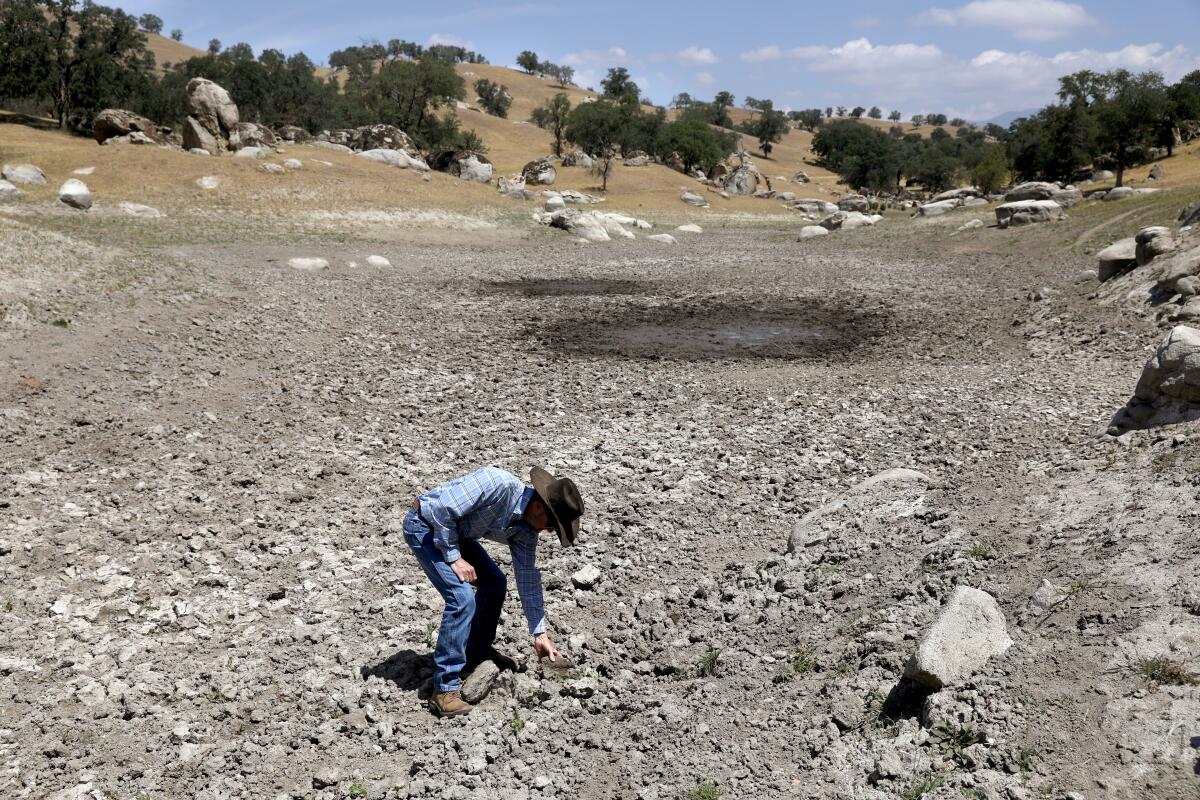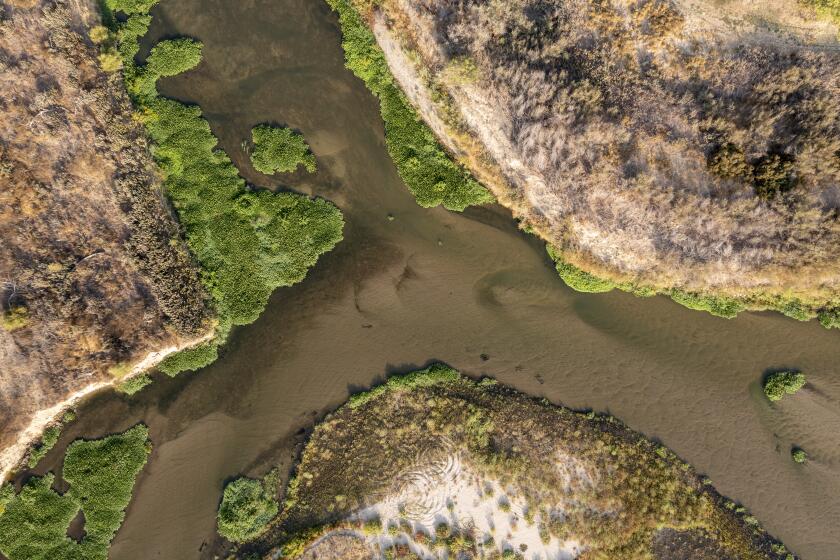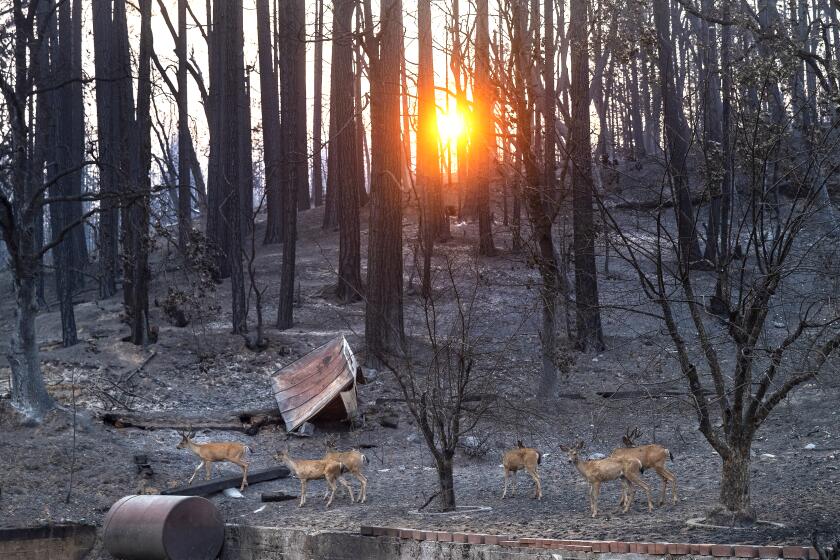Column: California is spending billions on drought-related projects. And it’s not borrowing to do it

- Share via
SACRAMENTO — State politicians have done something laudable, and it has gone unheralded. They haven’t even bragged about it themselves. So, here’s some heralding.
They’ve authorized spending about $5 billion on drought-related water projects without charging it on the credit card.
They’re going to pay cash. That will save taxpayers roughly twice the projects’ cost for tacked-on interest.
Normally, the politicians pay for water endeavors with borrowed money. It’s exceedingly rare when projects are funded with cash from the general fund, the state’s main banking account. A bond proposal is placed on the ballot and voters approve it. Investors purchase the bonds, and the state repays the buyers with interest for 20 or 30 years.
And the state goes deeper into debt.
As of last November’s election, the state was making $7 billion in annual payments on $80 billion in bonds. In addition, voters had approved $38 billion in bonds that were not yet sold.
Then, in that election, Californians authorized $5.5 billion more in bonds for stem cell research, costing a projected $260 million annually for 30 years.
Like a family, it’s wise for governments to avoid borrowing whenever possible.
Actually, Gov. Gavin Newsom and the Democrat-controlled Legislature don’t deserve loud heralding for their pay-as-you-go decision. Keep it at low volume.
Cash financing not only was possible, it was prudent. The governor and lawmakers would have been unforgivably wasteful if they’d done the normal borrowing.
Gov. Newsom declared a statewide drought emergency on Tuesday, which will help the state expedite drought relief projects, columnist George Skelton writes.
Tax revenue was pouring into state coffers like never before. There was an estimated $38 billion in discretionary surplus money. And the state has stashed an extra $14 billion in unexpected revenue since the current $263-billion state budget took effect July 1.
Sen. Anthony Portantino (D-La Cañada Flintridge) had introduced a $5.6-billion bond proposal for water supply, drought preparation, flood protection and wildfire prevention. He pushed it through three committees in the spring against weak Republican opposition, then shelved the legislation when it reached the Senate floor.
“I decided to take advantage of the [revenue] windfall and not put a bond on the ballot,” Portantino says. “It was the fiscally responsible thing to do.”
Portantino’s policy proposals plus much more — 25 bills in all — were wrapped into what Newsom predictably crowed was “the largest climate action package in state history.” The total cost: $15 billion — basically paid in surplus cash.
The “water and drought resilience” piece was allocated $5.2 billion to be rolled out over three years. Of that, roughly $400 million is money left over from three old water bond issues. The rest is new cash.
The money will be spent on a wide variety of worthy projects. They range from helping small, low-income San Joaquin Valley communities dig deeper wells where holes have dried up, to potentially assisting affluent La Cañada homeowners in Portantino’s district get off wasteful septic tanks.
Under Newsom’s declaration of a statewide drought emergency last week, separate disaster funds can be used to haul in drinking water for little towns with empty wells.
No specific projects have been identified in the water package. Local entities must apply to state government agencies for the money, and often put up dollars of their own.
The move from septic tanks to sewers — not just in La Cañada but throughout California — would be a water saver. That’s because sewer water can be recycled and used for landscaping, irrigating and golf courses. Septic waste seeps into the soil and contaminates groundwater with nitrates.
An atmospheric river could unleash debris flows and flash flooding across Northern California, especially in areas scorched by fire.
“It makes sense to capture the water instead of putting it into the ground where it’s not being used,” Portantino says. “And the water table is preserved.”
He says 2,000 La Cañada homes are on septic tanks because the cost of hooking up to sewers is prohibitive — up to $150,000 each due to steep hillsides and granite. The goal is to lower the homeowner cost to a more customary $10,000 to $25,000.
Sewer hookups are part of a $1.3-billion item largely for wastewater infrastructure.
One huge problem in the San Joaquin Valley is that farmers have been overpumping groundwater for decades, and it’s disappearing.
“We’ve been withdrawing without refilling,” state water resources director Karla Nemeth says. “It’s really important these groundwater basins be brought into balance.”
There’s $300 million to help do that. By law, it must be achieved within 20 years.
That invariably will mean fallowing hundreds of thousands of acres. So, there’s $50 million “to help with land repurposing,” Nemeth says. She suggests some farmers may want to switch from growing crops to planting solar panels as California moves more toward reusable energy.
Agriculture eats up 80% of California’s developed water. One little almond drinks a gallon before reaching your mouth. Urban and industrial use consume only 20%.
The draining of San Joaquin Valley aquifers has caused the land to sink several feet in some places, badly damaging major water canals. There’s $200 million for canal repairs over two years.
Another big groundwater problem is in the San Fernando and San Gabriel valleys. Aquifers were contaminated by aircraft manufacturing. So, $400 million was set aside for groundwater cleanup.
There’s also a $500-million kitty to immediately help local governments manage scarce water and provide drought relief.
“We’re getting California prepared for a third dry year,” Nemeth says.
But they’re also preparing for possible heavy drenching, like much of California received in recent days.
There’s $638 million for beefing up flood control. Thankfully it’s money on hand.
More to Read
Sign up for Essential California
The most important California stories and recommendations in your inbox every morning.
You may occasionally receive promotional content from the Los Angeles Times.













